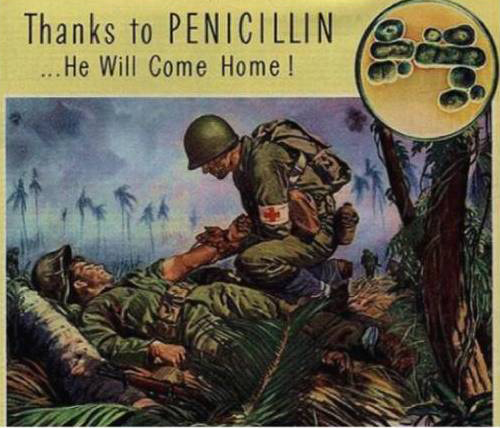LESSON PLAN:
Thanks to Penicillin… He Will Come Home! The Challenge of Mass Production
World War II saw major advances in medical technology including the mass production of penicillin. On March 14, 1942, U.S. made-penicillin was used to successfully treat the first patient for septicemia, or blood poisoning. While that one treatment exhausted half of the available supply of penicillin in the entire U.S., the need for better techniques for rapidly producing penicillin on a large scale was necessary to treat soldiers fighting abroad. Scientists working around the clock manufactured 2.3 million doses of penicillin in preparation for the D-Day landings on June 6, 1944. Explore with your students the important role of antibiotics on human history and the collaborative effort to mass produce penicillin.
Objective:
Students will analyze historic images and interpret the meaning of print materials. After reading text, students will think critically about the challenges of mass production and recognize the role of collaboration in scientific undertakings. Students will analyze the speed at which bacteria reproduce and explore exponential growth patterns. By identifying the function of antibiotics on the structure and function of bacterial cells, students will recognize the impact of antibiotics on human health during the 20th century.
Grade Level: 7-12 with enrichment activities for advanced students.
Standards:
NGSS HS-PS1-b - Science is a Way of Knowing – Science knowledge has a history that includes the refinement of, and changes to, theories, ideas, and beliefs over time.
NGSS MS-LS1-c - Develop and use models to support explanations about the structure and function relationships in cells and specific parts of the cell.
CCSS.Math.Content.7.NS.A.3 - Solve real-world and mathematical problems involving the four operations with rational numbers.
CCSS.ELA-Literacy.RST Standard 2 - Determine the central ideas or conclusions of a text; provide an accurate summary of the text distinct from prior knowledge or opinions.
CCSS.ELA-Literacy.RH Standard 7 - Integrate visual information (e.g., in charts, graphs, photographs, videos, or maps) with other information in print and digital texts.
NCHS U.S. History Content Standard 3C (9-12) - Evaluate the impact [of World War II] on science, medicine, and technology, especially in nuclear physics, weaponry, synthetic fibers, and television.
Time Requirement: One class period plus additional time for extension activities.
Materials: Copies (paper or digital access) of Thanks to Penicillin: He Will Come Home, Fact Sheet: The Challenge of Mass Production, and the Student Activity Sheet; Calculators.
Prior Knowledge: This lesson fits nicely with any microbiology unit. Prior student knowledge about bacterial cell structure and reproduction is recommended. You may follow this lesson with more specific instruction on the variety of antibiotics available today, how antibiotics function to destroy bacteria and inhibit growth, antibiotic resistance, the differences between Gram-positive and Gram-negative bacteria species, and the uses of bacteria in food production and industry. Mathematics teachers might modify this lesson to simply explore exponential growth.
Introduction: Show students the top portion of the advertisement, "Thanks to Penicillin…He Will Come Home!" Display on a video projector, overhead projector, or make copies for students to share. Use some or all of the questions to lead an introductory discussion about the history of the development of antibiotics and the effectiveness in treating bacterial infections. Hints are given after some questions in parentheses to help move the discussion forward.

Leading Discussion Questions:
- Take a look at this image. What is happening in the picture? (Hints for students: notice the smoke in the background; one man is laying down with the other holding his arm)
- Who are these men? (Notice their clothing and equipment, the cross on the man’s arm)
- What time period is this? (Observe the style of uniform, the message at the top of the picture)
- Where is this? (Palm trees, tropical plants)
- Read the title, "Thanks to Penicillin…He Will Come Home!" Who is the intended audience? (This was printed in Life magazine in August 1944.)
- Have you heard of Penicillin before? If so, how is it used? (Have you ever taken amoxicillin or "the pink stuff?" Why did you take it?)
- What do you see within the circle in the top right-hand corner? (This is a picture taken from a microscope.)
- What are these cells doing? (Look carefully at the cell on the bottom left-hand side, it is pinching inward.)
- How does penicillin affect these cells? (Now is a good time to discuss the bacterial cell wall; penicillin stops the growth of the cell wall causing lysis.)
Directions:
1. Reveal the entire advertisement. Have students read the text to meet the Common Core ELA Literacy Standard in History/Social Studies. Display on a video projector, overhead projector, or make copies for students to share.
2. Check for student understanding of the reading through formative assessment. Have students complete a one sentence summary of the reading, working individually. You might focus the students by asking them to describe the importance of penicillin to our victory in WWII. You may choose to collect student responses and/or have students share their answers with the class.
3. Distribute the Fact Sheet for students to read, meeting the Common Core ELA Literacy Standard in Science and Technical Subjects. You may choose for your students to read individually, as a small group, or as a class. Stop periodically to answer questions and clarify any terms from the reading.
4. Give the Student Activity Sheet to assess understanding of the reading. A calculator is recommended to complete the binary fission portion of the activity sheet.
Assessment:
Components for assessment include the student activity sheet, classroom discussion, and formative assessment.
Enrichment:
Graph exponential population growth on a linear or logarithmic scale (or both). Express population growth as an equation.
Discuss the mechanisms for and consequences of antibiotic resistance. Include the role of natural selection.
Research how drug manufacturing has changed with only one company making a specific drug. Students may explore the consequences, including drug shortages.
Fact Sheet

TAKE ACTION:


EDUCATION PROJECTS:
Student Travel – WWII Educational Tours
High school and college students, learn the leadership principles that helped win WWII on a trip to France or during a weeklong residential program in New Orleans. College credit is available, and space is limited.
See You Next Year! HS Yearbooks from WWII
Collected from across the United States, the words and pictures of these yearbooks present a new opportunity to experience the many challenges, setbacks and triumphs of the war through the eyes of America’s youth.
The Victory Gardens of WWII
Visit the Classroom Victory Garden Project website to learn about food production during WWII, find lesson plans and activities for elementary students, get tips for starting your own garden and try out simple Victory Garden recipes!
The Science and Technology of WWII
Visit our new interactive website to learn about wartime technical and scientific advances that forever changed our world. Incorporates STEM principles to use in the classroom.
Kids Corner: Fun and Games!
Make your own propaganda posters, test your memory, solve puzzles and more! Learn about World War II and have fun at the same time.



